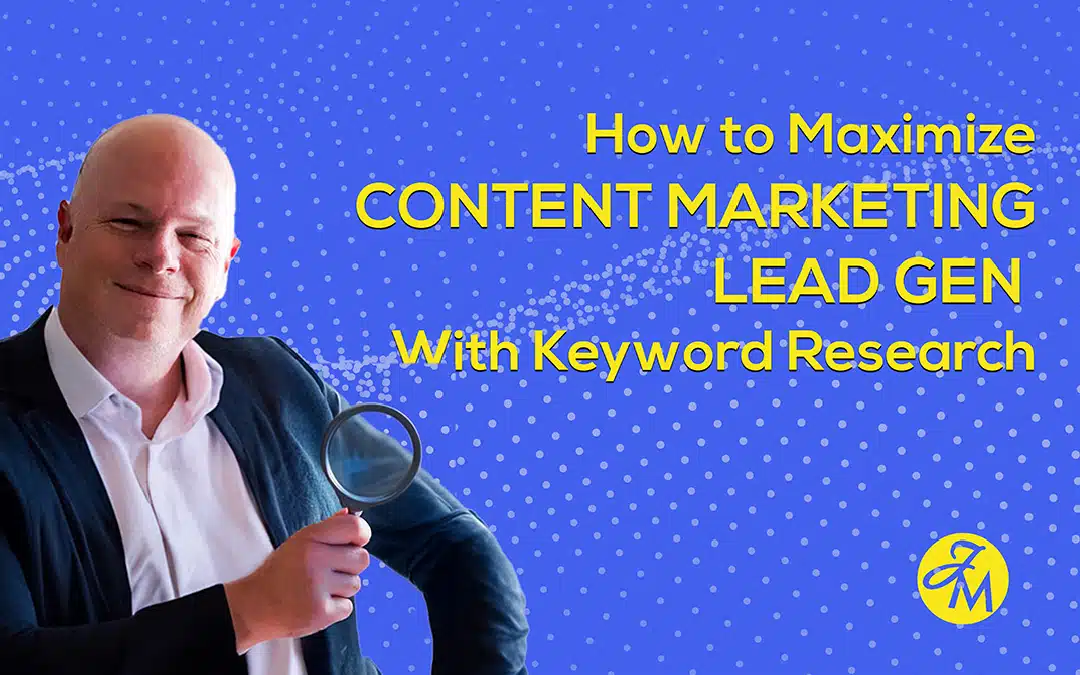Content marketing lead gen is crucial for businesses aiming to expand their customer base. However, crafting content that effectively generates leads can be a challenge. Many feel overwhelmed by content marketing.
This guide offers proven strategies to transform your content into a powerful lead-generating machine. We will explore practical approaches. We will help you attract and convert potential customers.
Table of Contents:
- Understanding Content Marketing Lead Gen
- Why Content Marketing Matters for Lead Generation
- Creating Content That Converts
- Optimizing Your Content for Lead Generation
- Distributing Your Content
- Measuring Your Success
- Conclusion
Understanding Content Marketing Lead Gen
Let’s clarify what content marketing lead gen truly involves. This approach centers on using valuable content to attract potential customers to your business. It steers clear of aggressive sales tactics, focusing instead on providing real value that naturally draws your target audience in.
This process of generation marketing is about building a relationship through helpful information. The goal is to position your brand as a go-to resource. This helps in consistently generating leads.
Consider an analogy: your content acts as the bait, and potential leads are the fish. The higher the quality of your bait – your high-quality content – the more effectively you will attract people and secure marketing leads. This content based strategy is fundamental to successful lead generation.
Why Content Marketing Matters for Lead Generation
Why is content marketing so significant for lead gen? The simple answer is its effectiveness in marketing lead generation. Statistics consistently show that a solid content marketing strategy can dramatically increase the number of qualified leads.
For instance, HubSpot research indicates that companies actively publishing blog posts generate significantly more leads than those that do not. This highlights the power of consistent content creation. Engaging content attract potential customers organically.
However, content marketing lead generation extends beyond just blog posts. It encompasses a diverse range of formats including blogs, podcasts, videos, and infographics. The crucial aspect is identifying the content type that best resonates with your specific target audience and supports your overall marketing strategy.
Creating Content That Converts
Now, let’s talk about how to create content that actually brings in leads. It is not enough to just put words on a page. You need to create content that resonates with your audience and moves them to action.
Know Your Audience
The first step in creating content that converts is deeply understanding your target audience. You must identify their specific pain points and challenges. Knowing what problems they face allows you to create content that genuinely resonates.
To achieve this, develop detailed buyer personas. Buyer personas are semi-fictional representations of your ideal customers, based on research and data. These profiles should include demographics, motivations, goals, and frustrations related to your product or service.
Understanding the customer journey is also vital. By mapping out the different funnel stages your potential customers go through, you can create content specific to their needs at each point. This helps in effectively guiding them towards conversion.
Solve Real Problems
Your content’s primary purpose should be to solve real problems for your target customer. Instead of merely promoting your products or services, demonstrate how they provide solutions. Focus on making your audience’s lives easier or improving their situation.
For example, if you offer financial planning services, create content that addresses common financial pain points. This could be a guide on budgeting, investing, or debt management. Providing valuable content that educates and helps builds trust and positions you as an expert.
This approach makes your content a go-to resource for your audience. When they see you consistently offer solutions, they are more likely to consider your business when it’s time to make a purchase. This problem-solving focus is key to attracting and converting a potential customer.
Use the Right Format
The format of your content significantly impacts its effectiveness in lead generation. Different content types serve distinct purposes and appeal to varied audience preferences. For instance, blog posts are excellent for search engine optimization and offering detailed information, helping to attract people organically.
Videos and podcasts videos can be highly engaging and more easily digestible for busy audiences. Visual content like infographics can simplify complex data, making it shareable. Ebooks white papers, and comprehensive guides serve as powerful lead magnets when offered as gated content.
Experimenting with various formats like case studies, webinars, and interactive quizzes is important. Analyze which content type performs best with your target audience. A diverse content mix ensures you cater to different learning styles and preferences, maximizing your ability to generate leads.
Here’s a quick look at some content types and their strengths for lead generation:
| Content Type | Primary Strength for Lead Gen | Example Use Case |
|---|---|---|
| Blog Posts | SEO, thought leadership, addressing specific pain points. | A detailed “how-to” article solving a common industry problem. |
| Ebooks & White Papers | In-depth information, valuable lead magnets, establishing authority. | A comprehensive guide on a complex topic, offered as gated content. |
| Case Studies | Social proof, demonstrating results, building trust. | Showing how your product/service helped a specific customer achieve success. |
| Webinars | Interactive engagement, direct Q&A, generating qualified leads. | A live session demonstrating your product and answering audience questions. |
| Videos & Podcasts | High engagement, easy consumption, personal connection. | Interviews with industry experts or short tutorial videos. |
| Infographics | Visually appealing, easily shareable, simplifying complex data. | Presenting industry statistics or process flows in a visual format. |
| Free Trial / Demo | Direct product experience, converting high-intent leads. | Offering a limited-time free trial of your software. |
Choosing the right content type depends heavily on your marketing goals and your target audience’s preferences. Quality content in any format can be effective if it delivers value. Consider offering gated content to capture leads directly.
Optimizing Your Content for Lead Generation
Creating great content is just the first step. You also need to optimize it for lead generation. Here are some tips to help you do that:
Include Strong Calls-to-Action (CTAs)
Every piece of your content must guide the reader toward a specific next action. This is achieved through strong Calls-to-Action (CTAs). CTAs can prompt users to sign up for a newsletter, download a content guide, request a free trial, or book a consultation.
Your CTAs should be clear, concise, and compelling, using action-oriented language. Make them visually prominent so they stand out on the page. Test different CTA placements, colors, and wording to see what drives the highest conversion rate.
Don’t leave your potential customer wondering what to do after consuming your content. Explicitly tell them the next step to take in their customer journey. This clarity is crucial for turning readers into marketing leads.
Use Landing Pages
Landing pages are essential tools in content marketing lead generation. These are standalone web pages created specifically for a marketing campaign, designed with a single conversion goal. They focus entirely on one offer, such as downloading ebooks white papers or signing up for a webinar, minimizing distractions.
Effective landing pages have a clear headline, persuasive copy highlighting benefits, engaging visuals, and a prominent contact form or CTA. By creating dedicated landing pages for each of your lead magnets or offers, you streamline the buying process for potential customers. This focus can significantly increase your conversion rate.
Ensure your landing pages are mobile-responsive and load quickly. The easier you make it for someone to convert, the more likely they are to become a qualified lead. Regularly test elements on your landing pages to optimize performance.
Implement Lead Capture Forms
Lead capture forms, often integrated into landing pages or as pop-ups, are how you gather information from a potential customer. Keep these forms as short and straightforward as possible. Only ask for the essential information your sales team needs to qualify and follow up on the marketing lead.
The length of your contact form can directly impact your conversion rate. Generally, the fewer fields you ask users to fill out, the higher the conversion. Balance the need for information with the user’s willingness to provide it, especially during initial funnel stages.
Consider implementing progressive profiling for your lead magnets. This technique allows you to gradually collect more data from leads as they engage with more of your gated content over time. For example, a first download might only ask for an email, while a subsequent interaction could request company size or job title, helping to build a more complete profile for lead nurturing.
Choosing Effective Lead Magnets
A critical component of content marketing lead gen is the use of compelling lead magnets. Lead magnets are valuable resources you offer to potential customers in exchange for their contact information, typically an email address. The right lead magnet can significantly increase your conversion rate when you offer gated content.
To be effective, your lead magnet must provide genuine value and solve a specific problem for your target audience. It should be highly relevant to the content they were consuming and their stage in the customer journey. Here are some popular types of lead magnets that help in generating leads:
- Ebooks and White Papers: These are excellent for a deep dive into complex topics, establishing your authority and providing comprehensive educational content. Ebooks white papers often attract users seeking in-depth knowledge, leading to more qualified leads.
- Checklists and Cheat Sheets: These are easily digestible and highly actionable. They provide quick wins for your audience, making them very popular as lead magnets.
- Templates: Offering templates (e.g., email templates, budget templates, content calendar templates) provides immediate practical value. People appreciate resources that save them time and effort.
- Webinars and Workshops: Live or recorded webinars allow for interactive engagement and can demonstrate your expertise effectively. They are great for generating leads who are further along the buying process.
- Case Studies: Detailed case studies showcase how your product or service has helped others achieve success. They build trust and provide social proof, making them effective for bottom-of-the-funnel leads.
- Free Trials or Demos: For SaaS companies or service providers, offering a free trial or a product demo is a direct way to let potential customers experience your solution firsthand. This often leads to high-quality leads.
- Resource Guides or Toolkits: Compiling a list of valuable tools, resources, or a step-by-step content guide can be an extremely attractive offer. This positions you as a helpful go-to resource in your industry.
- Quizzes or Assessments: Interactive quizzes can be engaging and provide personalized results, which can be a strong incentive for users to share their contact details. This content type helps in creating a personal connection.
When you offer gated content like these lead magnets, ensure the perceived value is high. Promote your lead magnets clearly within relevant blog posts, on your website’s key pages, and through your social media channels. Continuously test different lead magnets to see what resonates most with your target customer and drives the most conversions for your content based lead generation efforts.
Distributing Your Content
Creating great content is only half the battle. You also need to get it in front of the right people. Here are some ways to do that:
SEO
Search engine optimization (SEO) is fundamental to ensuring your high-quality content gets discovered by your target audience. Effective SEO involves using relevant keywords, including long-tail keywords, naturally within your content. It also includes building quality backlinks from reputable sources and maintaining a technically sound website architecture.
Beyond keywords, modern SEO prioritizes providing valuable content that thoroughly answers the searcher’s query. The search engine algorithms are designed to reward content that offers a great user experience. This means your content should be well-structured, easy to read, and comprehensive, addressing the user’s pain points directly.
Regularly audit your content’s SEO performance using tools like Google Analytics. Monitor rankings for target keywords, organic traffic, and engagement metrics. Optimizing existing content can be just as important as creating new material for sustained lead generation marketing.
Focus on creating topic clusters around your core services or products. This involves a central “pillar” page covering a broad topic in depth, linked to several “cluster” content pieces that explore specific subtopics. This structure helps search engines understand your expertise and can improve your rankings for a wider range of queries related to your generation marketing efforts.
Social Media
Social media platforms are powerful channels for content distribution and engaging with your target customer. Share your blog posts, videos, infographics, and other content on the social media networks where your ideal audience spends time. This not only increases visibility but also drives traffic back to your website where lead capture can occur.
Effective social media marketing is not just about broadcasting your content. It’s about fostering a personal connection and building a community around your brand. Engage with your followers, respond to comments and messages promptly, and participate in relevant conversations.
Tailor your content for each platform; what works on LinkedIn might not be suitable for Instagram. Use compelling visuals and concise captions to encourage clicks and shares. Consider using paid social media advertising to reach a wider, more targeted audience and promote specific lead magnets or gated content offers.
Utilize social listening to understand what topics are trending and what your audience is talking about. This insight can inform your content creation strategy. By consistently sharing valuable information and engaging authentically, you can build trust and position your brand as a helpful resource, ultimately leading to more qualified leads.
Email Marketing
Email marketing remains one of the most effective channels for lead nurturing and converting leads into paying customers. Use your email list to regularly share your latest blog posts, case studies, white papers, and other valuable content. This keeps your brand top-of-mind and provides ongoing value to your subscribers.
Segmenting your email list is crucial for delivering content specific to individual interests and needs. You can segment based on demographics, past engagement, position in the customer journey, or specific pain points identified. Personalized emails tend to have much higher open and click-through rates, leading to better engagement.
Develop automated email workflows for lead nurturing. For example, when someone downloads a lead magnet, trigger a series of emails that offer related content, share success stories, or invite them to a webinar or free trial. This systematic approach helps guide potential customers through the buying process efficiently, warming them up for your sales team.
Always include a clear call-to-action in your emails. Track metrics like open rates, click-through rates, and conversion rates from your email campaigns to continuously refine your email marketing strategy. Providing consistent value through email helps build loyalty and drive marketing lead generation.
Measuring Your Success
Measuring the success of your content marketing lead gen efforts is essential for understanding what works and where to improve. Your marketing team should regularly track key performance indicators (KPIs). This data-driven approach allows for continuous optimization of your content marketing strategy.
Here are some critical metrics to monitor for effective generation marketing:
- Website Traffic: Track overall site visits, traffic sources (organic, social, referral, direct), and page views for individual content pieces. This shows how well your content is attracting people. Use Google Analytics for detailed insights.
- Engagement Metrics: Monitor metrics like average time on page, bounce rate, scroll depth, and social shares. High engagement suggests your content is resonating with your target audience and addressing their pain points.
- Conversion Rate: This is a vital metric. Measure the percentage of visitors who complete a desired action, such as filling out a contact form, downloading a lead magnet, or signing up for a free trial. This indicates how effective your content is at generating leads.
- Lead Quality: Not all leads are equal. Assess the quality of leads generated by looking at how many become qualified leads (MQLs) and eventually sales qualified leads (SQLs). Align with your sales team to define lead quality criteria.
- Cost Per Lead (CPL): Calculate the CPL for your content marketing efforts to understand the efficiency of your spend. This helps in allocating budget to the most effective marketing tactics.
- Customer Lifetime Value (CLV) from Content Leads: Ultimately, the goal is to attract paying customers. Track the CLV of customers acquired through content marketing to understand its long-term impact on revenue.
- Return on Investment (ROI): Evaluate the overall ROI of your content marketing program to justify its value and secure ongoing support. This involves comparing the revenue generated from content leads to the cost of content creation and distribution.
Employ tools such as Google Analytics, your CRM system, marketing automation platforms, and specific SEO tools to track these metrics comprehensively. Regularly review your performance data, identify trends, and make data-backed adjustments to your content creation, distribution, and optimization tactics. Providing valuable content consistently requires ongoing analysis and refinement to ensure it continues to generate quality leads and contribute to business growth.
Understanding these metrics helps you demonstrate the value of your content marketing initiatives to stakeholders. It also guides your marketing team in making informed decisions. Effective measurement is the cornerstone of a successful content marketing lead generation program, helping to build awareness and attract your target customer.

Conclusion
Mastering content marketing lead gen is an ongoing process, not a destination. It requires dedication, a willingness to adapt your marketing strategy, and continuous learning. When approached thoughtfully, content marketing becomes an indispensable engine for business growth and customer acquisition.
The core principle remains: create high-quality content that genuinely helps your target audience and addresses their pain points. Optimize this content for lead generation by using effective calls-to-action, well-designed landing pages, and appropriate lead magnets. Then, ensure this valuable content reaches the right potential customers through strategic distribution across search engines, social media, and email marketing.
Building trust and a personal connection with your audience through educational content is paramount. It’s time to assess your current content marketing strategy. Identify opportunities to better understand your buyer personas, refine your content creation, and improve your lead nurturing processes to generate more qualified leads.
By consistently providing valuable content and focusing on the entire customer journey, from initial awareness to becoming paying customers, you transform your content into a reliable source of marketing leads. Your sales team will thank you for the steady stream of quality leads. Start today, refine your marketing tactics, and watch your business grow through effective content marketing lead generation.





